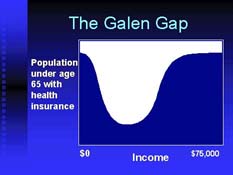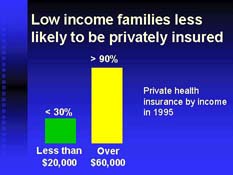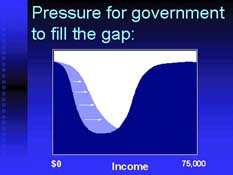Texas faces special challenges in trying to
increase access to affordable health insurance for its citizens. The
state's large and diverse population, coupled with a highly mobile
workforce, make it difficult for citizens to have reliable access to
health insurance.
Texas political leaders, like their counterparts in other states, are
looking at legislative solutions. Since the legislature will not meet to
address health care bills until this time next year, the state has an
opportunity to explore creative options.
More than 25,000 bills dealing with health care issues are being
considered in state capitols around the country this year, with hundreds
more before Congress in Washington. These bills are attempting to
address a multitude of problems in the health sector, including the
growing problem of the uninsured, the high cost of health insurance, and
access to specific health services. Unfortunately, when political
leaders tackle these problems, their primary weapons are legislation and
regulation. In virtually every other sector of the economy, the American
people realize the government regulation drives up prices, restricts
innovation, dries up competition, and forces businesses to cater to
regulators instead of consumers. That is exactly what is happening in
the health sector today.
Federal laws and regulations have woven an intricate web that is
turning the health sector into a public utility. As with communications,
airline, and utility deregulation, many of the problems in the health
sector could be addresses if the regulatory burden were lifted. Instead
of more laws and regulations, consumers need more freedom of choice in a
more competitive health sector.
The Galen Gap
The chart at below is a conceptual depiction of a central problem in
 the health sector that affects Americans under age 65. The
vertical axis of the graph in the logo represents the value of taxpayer
support for health insurance and medical services. The horizontal axis
represents individual income.
the health sector that affects Americans under age 65. The
vertical axis of the graph in the logo represents the value of taxpayer
support for health insurance and medical services. The horizontal axis
represents individual income.
Those with the very lowest incomes are most likely to qualify for
taxpayer- supported health programs, especially Medicaid. But as an
individual moves up the income scale (toward the right side of the
chart), the likelihood of qualifying for public health programs drops
off.
Those who are most likely to be uninsured are working Americans with
incomes of less than $25,000.  They are
caught in a trough which we call the "Galen Gap." They earn too much to
qualify for public programs but much are less likely to have the good
jobs that provide health insurance as a tax-free benefit.
They are
caught in a trough which we call the "Galen Gap." They earn too much to
qualify for public programs but much are less likely to have the good
jobs that provide health insurance as a tax-free benefit.
As people move up the income scale (on the right side of the chart),
they are much more likely to have both the good jobs and the higher
incomes to qualify for the generous tax subsidy for employment-based
health insurance, worth an estimated $100 billion a year.
Economist John Shiels of the Lewin Group estimates that the value of
tax subsidy for health insurance for someone making $100,000 a year or
more is $2,357, but the subsidy is worth only $71 a year for someone
making less than $15,000 a year. That means that the tax code provides a
generous subsidy for the purchase of health insurance for the top
executive of a company, and little or nothing for the waitress at the
corner restaurant or the clerk at the dry cleaner. Congress never would
have created such a regressive subsidy system intentionally. It has
evolved over the years because of a flaw in tax policy.
Many who want to expand government's role in the health sector have
been trying to fill the Galen Gap by creating and expanding government
programs, such as Medicaid and the State Children's Health Insurance
Program, and trying to expand Medicare to middle-aged Americans.
The Galen Institute works to explore solutions on the right side of
the chart  by focusing on tax policy. We believe that many more people
would have access to medical services and health insurance that would be
more affordable and more innovative if the tax treatment of health
insurance were reformed.
by focusing on tax policy. We believe that many more people
would have access to medical services and health insurance that would be
more affordable and more innovative if the tax treatment of health
insurance were reformed.
In Congress, a bipartisan and bicameral plan has been offered that
would extend health care coverage to an estimated 27 million employees
who are not already covered by employer-sponsored care, and or whose
earnings exceed eligibility thresholds for other federally-sponsored
health care programs, via series of federal tax credits. Sponsors of the
plan include House Majority Leader Dick Armey (R-TX) and Congressman
Calvin Dooley (D-CA), and Senators John Breaux (D-LA), Bill Frist (R-TN)
and Jim Jeffords (R-VT).
By providing tax credits directly to individuals for the purchase of
health insurance, the federal government would go a long way toward
equalizing the playing field for Texans and citizens of every other
state who want to purchase health insurance but who cannot afford the
full price of the policy.
State legislatures have an opportunity to begin implementing
solutions that will complement federal efforts and empower people, not
politicians, to make choices in obtaining more flexible and affordable
health insurance.
The State Children's Health Insurance Program (S-CHIP) is one such
opportunity. This joint federal-state program provides funds to provide
children with health insurance coverage. Several states have found that
they can cover more children through private insurance rather than
expanding Medicaid, the health program for the poor.
Utah, for example, asked private insurers in the state to bid on
providing coverage to children through the program. Four private
insurers are participating, and the parents of uninsured children have
their choice of plans. Gov. Michael Leavitt (R-UT) says children on
S-CHIP get "health insurance that's just as good as the governor's
children get, and we are covering twice as many kids as if we had
expanded Medicaid."
Texas could create a similar program and also could take advantage of
a provision in the S-CHIP legislation that would allow families to be
covered by private health insurance if it would cost no more than
covering the children in that family.
And the state could submit a request to the administrators of S-CHIP
in Washington that would give lower income working parents a voucher to
add their children to health plans they may receive at work, as
Massachusetts has done.
Texas can be a partner in solving its unique problems by focusing the
dollars where they are most needed…by helping people who are trying to
get off welfare but are fearful if they make too much they will lose
their health benefits…by helping parents to add their children to their
health plans at work…and by easing regulations and mandates that drive
up the cost of insurance and drive insurers out of the market.
Grace-Marie Arnett is president of the Galen
Institute, a public policy research organization based in Alexandria,
Virginia. She is the editor of Empowering Health Care
Consumers through Tax Reform, published in 1999 by the
University of Michigan Press.